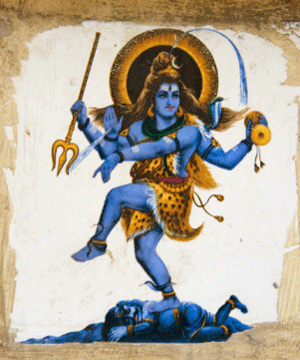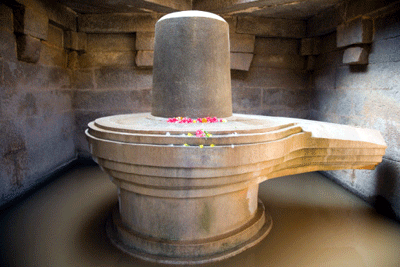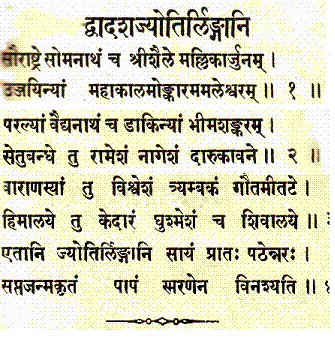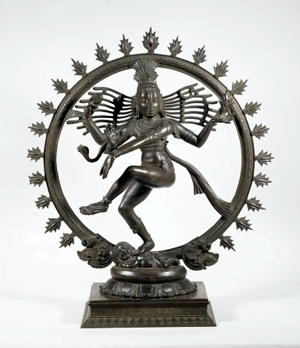Tomorrow (Friday-12-2-2010) is Mahashivarathri Day (The great night of Lord Shiva). This is one of the most important festivals for the Hindus of India and the world. Festivals are an important means of spiritual regeneration in Hindu Religion.
In addition to National Festivals, there are many State Festivals celebrated by Hindus in India. In one way or another, Hindus Festivals are associated with Hindu deities. Through these festivals, Hindus affirm their faith in their religion, culture and spiritual heritage that has existed for thousands of years, going back to the dawn of human history. The fixed dates for the celebration of festivals are determined by the Hindu Lunar Calendar (Panchanga) which is based upon the daily rising and setting of the moon, and on its waxing and waning characteristics.
Mahashivarathri falls on the 14th Day of the Dark fortnight (Krishna Paksha) in the month of Phalguna (February-March) and is dedicated to the worship of Lord Shiva. This festival is purely religious in nature and universally observed by all Hindus. On this Day devout Hindus observe fasting throughout the day and other austerities. Devotees sing Bhajans in honor of Lord Shiva, recite Sanskrit Slokas (Verses) from holy Hindu Scriptures, and offer prayers in the morning and evening. People visit nearby temples of Shiva and offer prayers in large crowds. The prayers and worship continue late into the night when the devotees offer cocoanut, Bilva leaves, fruits and specially prepared sacred food to Lord Shiva and his divine consort Goddess Parvathi. Offering Bilva leaves to Shiva on Shivarathri is considered very auspicious by all his devotees.
 The origin of Shivarathri is attributed to several stories in Hindu Mythology. One very popular story traces the origin of this festival to the churning of the Ocean of Milk by devas (Gods) and asuras (demons). It is said that when both Gods and demons were churning the Ocean of Milk to obtain amritha (Water of immortal life), they came across many unusual substances, including the deadly poison Kalakuta. As soon as they touched the poison, it exploded into poisonous fumes that threatened to envelope the entire Universe by darkness. When the destruction of the Universe seemed inevitable, the Gods ran for help and assistance to Lord Brahma and Lord Vishnu, but neither was able to help. At last they ran to Lord Shiva, who raised his trident and condensed the fumes. To save creation, Shiva swallowed the poison without spilling a single drop. The poison left a dark blue mark on Lord Shiva’s throat. That is why he known as ‘Neelakantha’. The Gods praised and worshipped Lord Shiva for saving the Universe.
The origin of Shivarathri is attributed to several stories in Hindu Mythology. One very popular story traces the origin of this festival to the churning of the Ocean of Milk by devas (Gods) and asuras (demons). It is said that when both Gods and demons were churning the Ocean of Milk to obtain amritha (Water of immortal life), they came across many unusual substances, including the deadly poison Kalakuta. As soon as they touched the poison, it exploded into poisonous fumes that threatened to envelope the entire Universe by darkness. When the destruction of the Universe seemed inevitable, the Gods ran for help and assistance to Lord Brahma and Lord Vishnu, but neither was able to help. At last they ran to Lord Shiva, who raised his trident and condensed the fumes. To save creation, Shiva swallowed the poison without spilling a single drop. The poison left a dark blue mark on Lord Shiva’s throat. That is why he known as ‘Neelakantha’. The Gods praised and worshipped Lord Shiva for saving the Universe.
Bansi Pandit has observed “The philosophical essence of the above story is as follows: Gods and Demons symbolize all kinds of individuals (both good and bad) in the world. The Ocean of Milk represents the ideal world that is full of peace and happiness for all human beings. Churning the Ocean of Milk signifies the human activity in the world. The Amritha symbolizes happiness and the poison represents human greed and selfishness. Shiva symbolizes the Athman (self), the spiritual essence of an individual. Worship of Shiva denotes meditation and contemplation by an individual on his or her own self”.
The above story is symbolic of the fact that individuals perform their actions in the world in order to achieve mental peace and happiness. In this process a person usually falls a prey to greed and selfishness and this fact ruins his or her efforts for obtaining peace and happiness. Thus the only way to achieve peace and happiness is by worshiping Lord Shiva at night, that is, by meditating upon one’s own self during the night on Shivarathri day when the individual is free from the distractions of the physical world. When the individual attains self-knowledge (Athma Gnana), he or she can live in the world without being affected by craving, anger, greed, attachment, pride, jealousy and egoism, the seven enemies of the soul (Athman). Therefore, Shivarathri symbolizes the worship of the Athman within.
After creation was completed, Parvati asked Lord Shiva as to which of the rituals pleased him the most, The Lord replied that the 14th night of the new moon, during the month of Phalguna, was his most Favorite Day. This night became Shivaratri. Parvati repeated Lord Shiva’s words to her friends and from then on, the word Shivarathri spread over all creation.
Mahashivaratri is on the most popular festivals of Hindus in Kashmir, especially that of Kashmiri Pandits. In Jammu and Kashmir, Shivratri is known as Hayrath or Herath (Believed to have derived from the Sanskrit "Hara (Shiva) ratri" - the night of Shiva). And the most important day of the festival is the 13th day of the dark half of Phalgun month. It is a day ahead of the normal Shivratri day in other parts of India. To Kashmiris, Mahasivaratri signifies Lord Shiva's wedding with Parvathi.
In the Shanti Parva of the Mahabharata, Bhishma, whilst resting on the bed of arrows and discoursing on Dharma, refers to the observance of Maha Shivaratri by King Chitrabhanu. The story goes as follows -
Once upon a time King Chitrabhanu of the Ikshvaku dynasty, who ruled over the whole of Jambudvipa, was observing a fast with his wife, it being the day of Maha Shivaratri. The sage Ashtavakra came on a visit to the court of the King.
The sage asked the King the purpose of his observing the fast. King Chitrabhanu explained that he had a gift of remembering the incidents of his previous birth.
The king said to the sage that in his previous he was a hunter in Varanasi and his name was Suswara. On the day of Shivarathri, this hunter who had killed many birds in a forest, was chased by a hungry lion. The hunter climbed a Bilva tree to save himself from the lion’s attack. The lion waited throughout the entire night at the bottom of the tree for its prey. In order to stay awake to avoid falling from the tree, the hunter kept plucking the leaves of the Bilva tree and dropping them below. The leaves fell on a Shiva Linga that happened to be at the bottom of the tree. Shiva was pleased by the offering of the Bilva leaves by the hunter, although inadvertently, and saved the hunter in spite of all the sin the hunter had committed by killing the birds. This story emphasizes the auspiciousness of worshipping Lord Shiva with Bilva leaves on Shivarathri Day.
 Jyotirlinga symbolizes the shrine of Lord Shiva. There are 12 Dwadasa Jyotirlingas at twelve places in India that are sacred to the Hindus. It is believed that all these twelve Jyotirlingas are “Swayambhus”, meaning that they sprung up by themselves at these places and temples were built upon them. The 12 Jyotirlingas are:
Jyotirlinga symbolizes the shrine of Lord Shiva. There are 12 Dwadasa Jyotirlingas at twelve places in India that are sacred to the Hindus. It is believed that all these twelve Jyotirlingas are “Swayambhus”, meaning that they sprung up by themselves at these places and temples were built upon them. The 12 Jyotirlingas are:
- Somnath in Saurashtra (Kathiawad), Gujarat
- Mallikarjun in Shrishailam or Srisailam in Andhra Pradesh (also listed as a Shakti Pitha site)
- Mahakal in Ujjain or Mahakalaswar at Ujjain in Madhya Pradesh.
- Omkar in Mammaleshwaram at Omkareshwar on the river Narmada in Madhya Pradesh
- Vaijnath in Parli (Vaidyanath at Deogarh in Bihar)
- Bhima Shankar in Dakini near Poona in Maharashtra
- Rameshwaram in Setubandha in Tamilnadu
- Nagesh, Naganath/Nageshwar,in Darukavana in Maharaashtra
- Vishweshwar/ Viswanath in Banaras/Varanasi in Uttar Pradesh
- Trimbakeshwar near Nasik on the banks of river Gautami/Godavari in Maharashtra
- Kedarnath/Kedareshwar in Uttarkhand
- Ghurmeshwar in Shivalaya or Grineshwar in Visalakam, near Ellora caves, in Maharashtra.
According to timeless and sacred Hindu tradition, any one who recites the names of these 12 Jyothirlinga regularly in the morning and evening washes away all the sins committed in his previous 7 births and attains all the powers and Siddhis. I am presenting below an ancient verse in Sanskrit which lists the names of all the 12 Jyotirlingas. This verse is chanted by millions and millions of devotees of Lord Shiva everyday.

“Saurashtre Somanathamcha Srisaile Mallikarjunam|
Ujjayinya Mahakalam Omkaramamaleswaram ||
Paralyam Vaidyanathancha Dakinyam Bheema Shankaram |
Setu Bandhethu Ramesam, Nagesam Darukavane||
Varanasyantu Vishwesam Tryambakam Gautameethate|
Himalayetu Kedaaram, Ghrishnesamcha shivaalaye||
Etani jyotirlingani, Saayam Praatah Patennarah|
Sapta Janma Kritam pApam, Smaranena Vinashyati||”
 In his famous book ‘The Tao of Physics’ Fritjof Capra (1939) has stated for all time: ‘The Wave Structure of Matter Explains the Atomic Structure of Matter. The ‘Particle’ as the Wave-Center of a Spherical Standing Wave in Space explains the cosmic dance of Nataraja’.
In his famous book ‘The Tao of Physics’ Fritjof Capra (1939) has stated for all time: ‘The Wave Structure of Matter Explains the Atomic Structure of Matter. The ‘Particle’ as the Wave-Center of a Spherical Standing Wave in Space explains the cosmic dance of Nataraja’.
In all his images, Lord Shiva is depicted in a human form. His body his naked and covered with ashes. The naked body indicates that He is free from attachments to the material things of the world. Since most things get reduced to ashes when burned, ashes symbolize the essence of all things and beings in the world. The ashes on the body of the Lord signify that. He is the source of the entire creation which emanates from Him.
Lord Shiva is depicted as having three eyes. The two eyes on the right and left indicate His activity in the physical world. The third eye in the centre of the forehead symbolizes knowledge (Gnana), and is thus called the eye of wisdom or knowledge. The powerful gaze of Lord Shiva’s third eye annihilates evil, and that is the reason why evil-doers fear His is third eye. The destructive power of Lord Shiva is symbolized by the snakes around His neck. In many pictures Shiva is depicted holding a trident in His right hand. In certain other pictures, a trident is shown standing adjacent to Him. A trident has three edges, which denote the three qualities of nature: Sattva (Inactivity), Rajas (Activity), and Tamas (Non-activity). The trident signifies the Lord is beyond the three qualities of nature. The trident also symbolizes the weapon that the Lord uses to destroy evil and ignorance in the world.
A damaru (small drum) produces sound when vibrated. As per Hindu scriptures the sound of vibration (of the sacred syllable OM) is believed to be the source of creation. A damaru in one of Lord Shiva’s hands conveys the idea that He holds the entire creation in His hand, folding or unfolding it at His will. Since a tiger symbolizes power, the tiger skin on which the Lord sits indicates that He is the source of infinite power which He controls at will. The crescent moon is shown on the side of the Lord’s head as an ornament and not as an integral part of His countenance. The waxing and waning phenomenon of the moon symbolizes the time cycle through which creation evolves from the beginning to the end and back to the beginning. Since the Lord is the Eternal Reality, the crescent moon is only one of His ornaments, and not an integral part of Him. The moon symbolizes the qualities of the heart such as love, kindness and compassion. The crescent moon near the Lord’s head conveys the idea that a devotee must develop these qualities in order to become closer to the Lord.
 Lord Shiva is also known as Nataraja, the Dancing God. This divine art form is performed by Lord Shiva and his divine consort Goddess Parvati. The dance performed by Lord Shiva is known as Tandava. Shiva’s Tandava is a vigorous dance that is the source of the cycle of creation, preservation and dissolution. Tandava depicts his violent nature as the destroyer of the universe.
Lord Shiva is also known as Nataraja, the Dancing God. This divine art form is performed by Lord Shiva and his divine consort Goddess Parvati. The dance performed by Lord Shiva is known as Tandava. Shiva’s Tandava is a vigorous dance that is the source of the cycle of creation, preservation and dissolution. Tandava depicts his violent nature as the destroyer of the universe.
According to scholars, ‘Divine Characteristics of the Tandava Dance’ have been described in the fourth chapter of Bharat Muni’s Nata Shastra, which is referred to as fifth Veda and an expression of Lord Shiva’s eternal dance - Tandava. It says that Shiva’s Tandava is embellished with 108 karanas and the 32 anghaharas - the composite parts of the dance. Bharat Muni further says that Lord Shiva conceived the dance, as he was very much fond of dancing every evening. Lord Shiva further indicated that the 108 karnas included in Tandava could be employed in the course of dance, fight, and personal combats and in other special movements like strolling.
Some scholars believe that there are eight (8) different types of Tandava. The Tandava performed with joy is called Ananda Tandava and that which is performed in a violent mood is called Rudra Tandava. The other types of tandava identified are Tripura Tandava, Sandhya Tandava, Samhara Tandava, Kaali Tandava, Uma tandava and Gauri Tandava. The Hindu Agamas describe these different forms of Dance of Lord Shiva. However, there are certain other scholars who believe that there are sixteen (16) types of tandava.
What is the significance of Lord Shiva’s Tandava Nritya? According to religious scholars, the cosmic dance of Shiva, called ‘Anandatandava,’ meaning, ‘the Dance of Bliss’ symbolizes the cosmic cycles of creation and destruction, as well as the daily rhythm of birth and death. The dance is a pictorial allegory of the five principle manifestations of eternal energy—creation, destruction, preservation, salvation, and illusion.
According to the great Art Historian Dr. Ananda Coomarsamy, (1877-1947) the dance of Shiva represents his following five activities namely, ‘Shrishti’ meaning creation and evolution; ‘Sthiti’ meaning preservation and support; ‘Samhara’ meaning destruction and evolution; ‘Tirobhava’ meaning illusion and finally ‘Anugraha’ meaning release, emancipation and grace.
Dr. Ananda Coomarasamy states in his famous book on the Dance of Shiva that Lord Shiva as represented in the Nataraja form is a remarkably resplendent wonder of the aesthetic world. He puts it in inimitable words of indescribable beauty: ‘The Indian Nataraja may well be claimed as the clearest, most logical and impassioned statement of the conception of life as an eternal Becoming. This is His dance in the last night of the world when the stars fall from their courses and all is reduced to ashes, to be ever rekindled, ever renewed by the boundless power of the Lord. The Dionysian frenzy of his whirling dance presents affirmation of the eternal, unseen spectacle of the dynamic disintegration and renewal, birth and death, of all cosmic matter in every second as in every kalpa of time’. Thus Nataraja typifies the universe in the action of creation and destruction. The overall temper of the image is paradoxical, uniting the inner tranquility, and outside activity of Lord Shiva.
Dr. Ananda Coomarasamy was clearly able to see beyond the unsurpassed rhythm, beauty, power and grace of the Dance of Nataraja, when he described it eloquently: ‘Whatever be the origins of Shiva’s dance, it became in time the noblest image of activity of God which any art or religion can boast of.’
Sir Jacob Epstein (1880-1959), leading English Sculptor, also wrote about Shiva Nataraja: “Shiva dances, creating the world and destroying it, his large rhythms conjure up vast eons of time, and his movements have a relentless magical power of incantation. Our European allegories are banal and pointless by comparison with these profound works, devoid of the trappings of symbolism, concentrating on the essential, and the essentially plastic’. Siva is the Divine Dancer, visualized in terms of motion and vibration, who in 108 various movements interprets the mathematical Law of the Universe.
The Natya Sastra or the Science of Dance enumerates 108 modes (Karanas) of dance and all these are found sculptured on either side of the doorway of Chidambaram Temple, Tamilnadu, India. Anyone who wants to know the secret of the Universe is advised to go to the Cidambaram Temple situated in Tamilnadu, India where Lord Nataraja is the presiding deity. Any one who understands the Dance of Shiva Nataraja could easily understand the mysteries of the Universe.
My friend and great Scholar G.P. Srinivasan has invited my attention to the fact that on June 18, 2004, an unusual new landmark was created at CERN, the European Centre for Research in Particle Physics in Geneva. A 2m tall statue of the Indian deity Shiva Nataraja, the Lord of Dance has been installed at the Centre. The statue, symbolizing Shiva’s cosmic dance of creation and destruction, was given to CERN by the Indian Government to celebrate the research Centre’s long association with India.
The symbolism of Shiva’s Cosmic Dance is strong and simply overpowering. As scientists at the European Organization for Nuclear Research at (CERN) near Geneva smash subatomic particles in the world’s largest experimental Centre, Lord Shiva, the destroyer, continues to keep a cosmic watch over it all, standing in close proximity in the immediate neighborhood.
In choosing the image of Shiva Nataraja, the Indian Government has acknowledged the profound significance of the metaphor of Shiva’s dance for the cosmic dance of subatomic particles, which is observed and analyzed by CERN’s physicists. The parallel between Shiva’s dance and the dance of subatomic particles was first discussed by Fritjof Capra in 1972 in an article titled ‘The Dance of Shiva: The Hindu View of Matter in the Light of Modern Physics' Shiva’s cosmic dance then became a central metaphor in Capra’s international bestseller The Tao of Physics, first published in 1975 and still in print in over 40 editions around the world.
A special plaque next to the Shiva statue at CERN in Geneva explains the significance of the metaphor of Shiva’s cosmic dance with several quotations from The Tao of Physics. Here is a quotation from Fritjof Capra that has been put in that special plaque ‘Modern physics has shown that the rhythm of creation and destruction is not only manifest in the turn of the seasons and in the birth and death of all living creatures, but is also the very essence of inorganic matter and for the modern physicists, then, Shiva’s dance is the dance of subatomic matter. Hundreds of years ago, Indian artists created different forms of visual images of dancing Shiva in a beautiful series of bronzes. In our time, physicists have used the most advanced technology to portray the patterns of the cosmic dance. The metaphor of the cosmic dance thus unifies ancient mythology, religious art and modern physics.’
In his Introduction to his famous book The Tao of Physics Capra had narrated his experience while gazing at the Pacific Ocean. His entire field of vision just disappeared and was replaced by an irrepressible Cosmic Consciousness, which he could identify and which he was later able to relate to Advaitha of Hindu Philosophy of gaining cosmic vision. To conclude in the words of G.P. Srinivasan: ‘For the first time this made history for the philosophy of yoga and principles of quantum physics were merged into seamless realism’.
To conclude in the exquisite and ecstatic words of Shonar: “Ancient Bharatha—where does she begin? When did she end? Or has she even ended? There are those who say no. They say she has no beginning, no end, like the Brahman that she loves and swears by, which begins from nothing and ends into nothing. Timeless and Everlasting!
 The origin of Shivarathri is attributed to several stories in Hindu Mythology. One very popular story traces the origin of this festival to the churning of the Ocean of Milk by devas (Gods) and asuras (demons). It is said that when both Gods and demons were churning the Ocean of Milk to obtain amritha (Water of immortal life), they came across many unusual substances, including the deadly poison Kalakuta. As soon as they touched the poison, it exploded into poisonous fumes that threatened to envelope the entire Universe by darkness. When the destruction of the Universe seemed inevitable, the Gods ran for help and assistance to Lord Brahma and Lord Vishnu, but neither was able to help. At last they ran to Lord Shiva, who raised his trident and condensed the fumes. To save creation, Shiva swallowed the poison without spilling a single drop. The poison left a dark blue mark on Lord Shiva’s throat. That is why he known as ‘Neelakantha’. The Gods praised and worshipped Lord Shiva for saving the Universe.
The origin of Shivarathri is attributed to several stories in Hindu Mythology. One very popular story traces the origin of this festival to the churning of the Ocean of Milk by devas (Gods) and asuras (demons). It is said that when both Gods and demons were churning the Ocean of Milk to obtain amritha (Water of immortal life), they came across many unusual substances, including the deadly poison Kalakuta. As soon as they touched the poison, it exploded into poisonous fumes that threatened to envelope the entire Universe by darkness. When the destruction of the Universe seemed inevitable, the Gods ran for help and assistance to Lord Brahma and Lord Vishnu, but neither was able to help. At last they ran to Lord Shiva, who raised his trident and condensed the fumes. To save creation, Shiva swallowed the poison without spilling a single drop. The poison left a dark blue mark on Lord Shiva’s throat. That is why he known as ‘Neelakantha’. The Gods praised and worshipped Lord Shiva for saving the Universe.  Jyotirlinga symbolizes the shrine of Lord Shiva. There are 12 Dwadasa Jyotirlingas at twelve places in India that are sacred to the Hindus. It is believed that all these twelve Jyotirlingas are “Swayambhus”, meaning that they sprung up by themselves at these places and temples were built upon them. The 12 Jyotirlingas are:
Jyotirlinga symbolizes the shrine of Lord Shiva. There are 12 Dwadasa Jyotirlingas at twelve places in India that are sacred to the Hindus. It is believed that all these twelve Jyotirlingas are “Swayambhus”, meaning that they sprung up by themselves at these places and temples were built upon them. The 12 Jyotirlingas are: In his famous book ‘The Tao of Physics’ Fritjof Capra (1939) has stated for all time: ‘The Wave Structure of Matter Explains the Atomic Structure of Matter. The ‘Particle’ as the Wave-Center of a Spherical Standing Wave in Space explains the cosmic dance of Nataraja’.
In his famous book ‘The Tao of Physics’ Fritjof Capra (1939) has stated for all time: ‘The Wave Structure of Matter Explains the Atomic Structure of Matter. The ‘Particle’ as the Wave-Center of a Spherical Standing Wave in Space explains the cosmic dance of Nataraja’. Lord Shiva is also known as Nataraja, the Dancing God. This divine art form is performed by Lord Shiva and his divine consort Goddess Parvati. The dance performed by Lord Shiva is known as Tandava. Shiva’s Tandava is a vigorous dance that is the source of the cycle of creation, preservation and dissolution. Tandava depicts his violent nature as the destroyer of the universe.
Lord Shiva is also known as Nataraja, the Dancing God. This divine art form is performed by Lord Shiva and his divine consort Goddess Parvati. The dance performed by Lord Shiva is known as Tandava. Shiva’s Tandava is a vigorous dance that is the source of the cycle of creation, preservation and dissolution. Tandava depicts his violent nature as the destroyer of the universe.